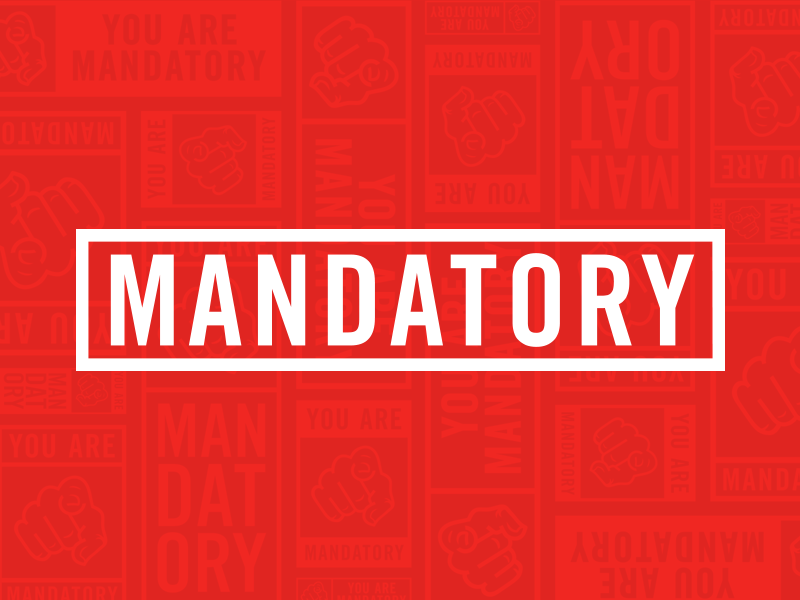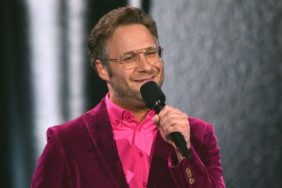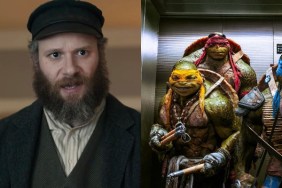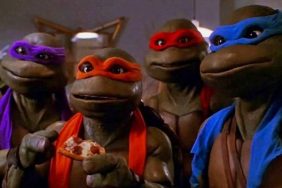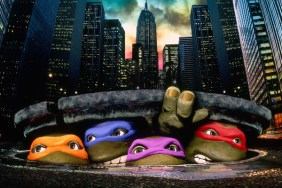No, we aren’t talking about the new film coming out in August 2014 from Michael Bay (with Megan Fox cast as April O’Neil). We are talking about the good one. The original. The one we have all seen and love. Most of us grew up with the Teenage Mutant Ninja Turtles in one way or another, but this was the film that started it all. Now, we’re aware of the fact that it is actually based on a comic book and that the even more popular 1987 cartoon series paved the way for it’s success. In actuality, however, the film was supposed to come first. But due to its bizarre premise and dark, gritty tone (meant to be a direct adaptation from the comics originally), no studios in the U.S. wanted to invest, delaying the process several years. It’s little tidbits of information like this that we are about to hurl at you with rapid fire succession in this piece that has everything you could possibly need to know about the 1990 Teenage Mutant Ninja Turtles movie. Cowabunga!
1. As mentioned, no one wanted to make this movie. Even as filming began, it had not yet been picked up by a studio. It took months before New Line Cinemas finally signed a deal to buy it. And they were surely glad they did, as Teenage Mutant Ninja Turtles became the highest grossing independent film ever (Budget: $13.5 million, Gross: $135 million), until being surpassed by The Blair Witch Project (Budget: $60,000, Gross: $140.5 million) nine years later.

2. Have you ever wondered why you or any of your friends never had toys from this film, but you did for its cartoon counterpart, as well as its sequels? It’s because Playmates Toys declined to make figures based on the first film due to its violent nature, language and overall tone. However, once the sequels opted for a lighter feel, the toy company changed their tune as well, producing the “Movie Star Teenage Mutant Ninja Turtles” line.
3. There is a scene in the film where the Tatsu character goes nuts and beats up a bunch of his fellow Foot Clan. He beats one boy so badly that in the original script as well as the novelization, he is said to have killed him. However, sounds of the boy breathing, as well as people saying that he is alright, were added to the scene at the last minute because the movie ratings board objected to the death.
4. While Jim Henson was said to be upset by the amount of violence in the finished film, the turtle costumes were created by his Creature Shop in London. Henson said that the costumes were the most advanced

that he had worked with at the time. His involvement in this film and the sequel Teenage Mutant Ninja Turtles II: The Secret of the Ooze probably explains why the Ninja Turtles were alluded to in Muppet Babies, Muppets Tonight and Dinosaurs, where a “Teenage Mutant Ninja Cavemen” poster could be seen hanging in the character Robbie’s bedroom.
5. While most elements of the film are adapted from the comics, the turtles love of pizza, their multi-colored bandanas, April O’Neil being a news reporter instead of a lab assistant to a scientist, Michelangelo’s surfer accent and “Cowabunga” all came from the 1987 cartoon series. Oh, what a glorious blend.
6. In the comics that the particular storyline was based on, it was actually Leonardo who was ambushed and beaten on the rooftops of New York City. In the film, it is Raphael. This was rectified and done according to the comics in the 2003 “Teenage Mutant Ninja Turt

les” animated series.
7. Even though the film is supposed to take place in New York City, it actually only shot there for four days. The remainder (and bulk) of the film was shot in Wilmington, North Carolina. April O’Neil’s news station was actually a real news station in Wilmington, and the sewers were just a giant set. Even the fight sequence in the streets and on the rooftops at the end of the film was shot on a giant New York City set that was repurposed from the cult favorite “Big Trouble in Little China.”
8. We all know the Raphael line “Cricket? Nobody understands cricket. You gotta know what a crumpet is to understand cricket.” It is said during his big fight with Casey Jones in Central Park. However, the irony of that line is that, because they were filming in rural Wilmington, North Carolina, there actually were crickets everywhere chirping very loudly. If you listen closely, you can still hear loud cricket noise in the background, even though they were edited out as best as they could be.
9. Teenage Mutant Ninja Turtles was the first film edited by Sally Menke. That name may not be familiar, but she went on to be the editor and collaborator for all of Quentin Tarantino’s films until she sadly passed away in 2010.
10. You’ll notice that in the film, the character of Danny is always seen wearing a shirt with “The Sex Pistols” bassist Sid Vicious on it. This reflects the musical taste of director Steve Barron, who wanted a soundtrack with an indie/punk/”The Clash” vibe. Unfortunately, the producers wanted something more commercial, and that is why we got songs like “Turtle Power” instead (in which the lyrics don’t even get the leader of the group right).
11. Judith Hoag, who

played April O’Neil in the film, has said that she “was never satisfied with how [Teenage Mutant Ninja Turtles] came out.” It is said that she did not sign on for the sequels because of substantial edits to scenes involving her character.
12. During the conclusion of the film, the head thug (played by Sam Rockwell, believe it or not) tells police to “go check out the East Warehouse over at Lairdman Island.” This is a shout out to the creators of the Teenage Mutant Ninja Turtles comics: Kevin Eastman and Peter Laird.
13. Pizza Hut engaged in a $20 million marketing campaign to promote Teenage Mutant Ninja Turtles by means of rebate coupons and print, radio and television ads. Ironically, Domino’s is the pizza chain that the turtles are seen ordering in the film.

14. Speaking of Domino’s, Michelan Sisti, who wore the Michelangelo suit for the film, also played the Domino’s delivery man. Likewise, Josh Pais, David Forman and Leif Tilden, who wore the Raphael, Leonardo and Donatello suits respectively, also had minor roles in the film other than that of the turtles.
15. Every turtle besides Raphael had an actor wearing the suit, and a separate actor doing the voice (Josh Pais handled both for Raphael). Even the characters of Shredder and Tatsu had their voices dubbed over. Donatello’s voice actor, Corey Feldman, was the most notable at the time.
16. The actors inside the suits all lost at least 20 pounds by the end of production due to the immense North Carolina heat and humidity. The fact that the suits were already very heavy and 60 pounds of animatronics were stored in the shell probably didn’t help matters. In the scene where April’s apartment catches ablaze, it got so hot for the actors inside the suits that they could only do one or two takes before having to move on. That’s a lot of pressure, but they pulled it off.
17. It took three puppeteers to operate Splinter. The most notable of those three was Kevin Clash (the voice and puppeteer of Elmo from Sesame Street), who also voiced the character.
18. So many lines and scenes in the film, such as the Donatello/Casey Jones claustrophobia exchange, doubl

e as inside jokes. Josh Pais would occasionally get very claustrophobic inside his Raphael costume and need to have the crew come and pull his mask off. Unfortunately for him, it was not a fast or easy process.
19. Since there was a commercial flight path over the farm where a huge part of the film was shot, sometimes radio signals from the planes above would interfere with the facial animatronics of the turtle costumes, causing them to have involuntary spasms.
20. We know it’s never manly to cry, but in the case of Splinter, it wasn’t safe either. That’s because the liquid used to give the appearance of Splinter’s tears actually ate away at the latex underneath. Director Steve Barron had to fight with the Henson team to get them to use more in order to make Splinter’s emotions seem more believable.

21. There was so much wear and tear to all of the turtle costumes that they were constantly being touched up. Whole new replacement limbs were kept on hand, as they had to be switched out quite often.
22. The turtle costumes were actually too big to fit through a standard-size manhole, so custom manholes had to be built. Another problem with the costumes was that it was very hard to see out of them due to the fact that the eye holes were just tiny slits beneath the masks, which you can see if you look close enough.
23. As with any movie involving complicated puppets and animatronics, there are bound to be mistakes involving the people running the creatures accidentally being caught on camera. Teenage Mutant Ninja Turtles is no exception by a long shot.
